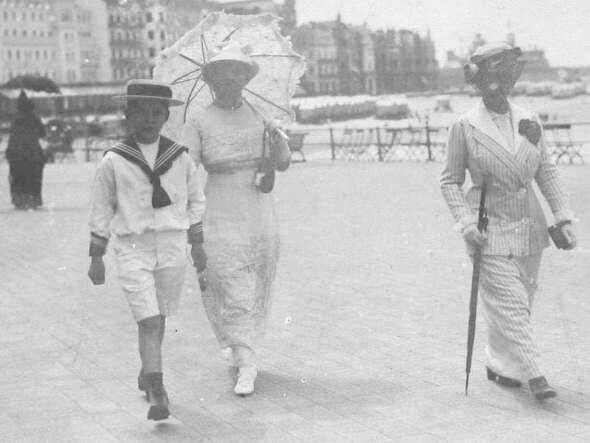
Belgian Boys Activities: Outings

Figure 1.-- This photograph shows with a postcard back shows two fashionable ladies and boy, presumably one of their sons, dressed up for an outing. They are taking a walk along what we believe to be promenade at Ostend--one of the major Belgian beach resorts. The portrait looks to have been taken about 1905.
Printed on the back is the photographer: Photographie Luckefett - Ostende - Biarritz - Cannes. It comes in a paper wallet marked L. Van de Vyver.
|
|
We do not yet have much information on the outings taken by boys. Many are outings taken by family groups. Other by be taken by groups of boys. We suspect that we are talking about activities similar to those in neighboring countries (France, Germany, and the Netherlands). Here we are talking about both family tripsand trips by groups of boys. Popular outings include urban parks, zoos, picnics in the country, are trips to the country's many long, sandy beaches. Biking was also popular. We are less sure about fishing and boating. Belgian does havev many rivers where boys could fish. Our Belgian readers may have more information on such outings.
Beaches
Belgian has some wonderful sandy beaches that streach out gradually leaving a very wide beach area. There is a fairly narrow ocean area. The Belgian beaches are located at just the point the North Sea narrows into the Dover Straits and the English Channel. The Netherlands has a larger ocean front, but not the wide Belgian beaches. The best known beach restort in Belgium is Ostend. The photograph here shows two fashionable ladies and boy, presumably one of their sons, dressed up for an outing (figure 1). They are taking a walk along what we believe to be promenade at Ostend--one of the major Belgian beach resorts. The portrait looks to have been taken about 1905. Another important beach is Dunkirk, better known world wide because of the World War II British evacuation. The famous pictures of the evacuation point to use how wide the beach is.
We do not have agreat deal of information about the history of circuses. They clearly date to Roman times as the term is a Roman one. The largest was the Circus Maximus in Rome. The major Roman circuses commonly involved combat and gladiators as well as horse races. In fact the kinds of entertaimnment today associated with the circus (exotic animals, acrobats, jugglers, and clowns)tended to be used beteen major events to keep the audience entertained. We are not
sure to what extent circuses traveled, but the well established Roman roads made this possible to a greater extent than would be possible until the modern age. The Roman circuses were performed in a open air oval or circular showground (the Colliseum was oval). There were permanent stone tiered seating commonly flanking the edges. There was also traveling circuses that performed under a large tent. There is no direct connection between Roman and modern cicuses. After the fall of Rome, commerce declined and rads deteriorated. There was no rel way of transporting a circus. Individual entertainers including some with trained animals began to appear in markets and at festivals. Traveling entertaining groups which laid the foundation for the modern circus may have introduced by gypsies who traveled widely in Europe (14th-15th century). The first permanent traveling circus appears to have been estanlished by Philip Astley in Britain. His circus performed in both Brtain and the Continent (late-18th centutry). The circus became enormousy popular in England. Ashley introduced horses trained to do tricks. Cities began corstructing buildings to accomoidate them. London built the Hippodrome which was a multi-purpose theater. Antonio Franconi emerged as the founder of the French circus at about the same time as Ashley. Cicuses also appeared in North america. Joshuah Purdy Brown began using a large tent for his corcus (1825).
Sevral Europeans founded importabt circuses: Giuseppe Chiarini (Italian), Jacques Toruniaire (French), Louis Soullier (French), and others performed throughout Europe and even traveled to Asia and the Americas. Soullier was impressed with Chinese acrobatics and brought them back to Europe (1866).
These major circuses performed in Belgium and other small countries. Bouglione is the best known Belgian circus which began operating (1830). In addition to the major circuses there were many smaller circuses which had more limited performances , but which offered the children and adults and immediacy and close connectiin with the performers that can not be replicated by the larger circuses.
Parks
Picnics
HBC

Navigate the Boys' Historical Clothing Web Site:
[Return to the Main Belgiam activities page]
[Introduction]
[Activities]
[Biographies]
[Chronology]
[Clothing styles]
[Countries]
[Bibliographies]
[Contributions]
[FAQs]
[French glossary]
[Dutch glossary]
[Images]
[Links]
[Registration]
[Boys' Clothing Home]
Navigate the Boys' Historical Clothing Belgin pages:
[Return to the Main Belgian page]
[Belgian catalogs
[Belgian choirs]
[Belgian movies]
[Belgian royals]
[Belgian schools]
[Belgian youth groups]
Created: 12:08 AM 2/10/2008
Last updated: 5:42 AM 12/27/2017



